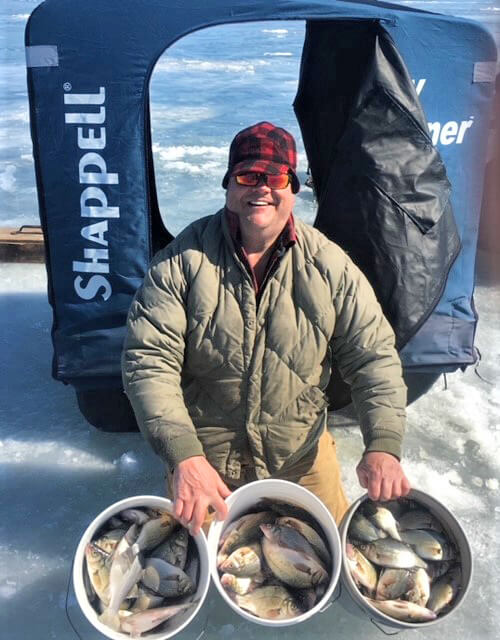Vernacular strategies for flushing an ‘outta stater’ on the ice
The milky surface ice has begun to pull away from the rocky, pebbled shoreline of the bay. Tiny vertical prisms are visible in the hoarfrost-like honeycomb of the decaying core.
There is water about 6 inches deep extending out 2 feet from the shore. Some kind fool has placed an 8-foot-long, 2-by-10 board extending from the shoreline out onto the thicker ice. I can see the boot prints of those who have courageously crossed this mini bridge. You may ask yourself, “What kind of person would dare walk out on this ice? Is this display of judgment indicative of how they would live their entire life?”
The answer to this question is buried deep in the soul of the avid outdoorsman. Others may see him or her as someone who may make poor life choices, but to the ice fisherman pursuing the late winter spawn of white perch, it is a calculated risk. I have known eight men who have succumbed to the depths of Lake Champlain.
When I make the decision to walk the plank, it is their memory that causes me to be more cautious than those boot prints before me. In my 30 years of ice fishing, I have learned to read the ice by noticing its shapes, softness, clarity and have considered the effect of sunlight magnifying its strength through the surface. And still, I will always have my flotation suit on, my ice picks ready around my neck, a long rope with a grip loop on one end and a whistle attached to a lanyard.
And I never go alone. I will never be the first guy out on the ice. I may not catch as many as others do, but in my book, even with my love of white perch Thai fish cakes, no fish is worth dying for.
So, tenuously, I walk the plank, after seeing a dozen others before me. I am dragging my old black jet sled with my auger, fish finder, rods and lures that we ice fishermen refer to as “bibbits,” a comfortable folding chair and three large 6-gallon buckets.
The buckets represent the epitome of optimism. A few times in the past, my team of hardcore fishermen have been able to fill all three buckets with white perch known to the academics as Morone americana (actually a member of the bass family), but for one of those colloquialisms that Vermonters love so much it has been dubbed the “white perch.”
If you’ve lived in Vermont long enough and been outside of Chittenden County, you’ve been exposed to the local vernacular — words like “Jeezum Crow,” “pahtridge” and “You can’t get there from heah.”

If someone argues with you that this fish is not a perch at all, you’re facing off with either a biologist or some poor college-educated kid from outta state. My advice: Ask them to walk out on the plank with you, to get to the thick ice and fish with you for the day. If they do, and you “get into the fish,” they will drop their pretense and accept the Vermonter’s true moniker.
So, here we sit, side by side, when the fish finder lights up like a Christmas tree — all the colors of the rainbow in a vertical column from the bottom of the bay at 30 feet to the top just below the surface. Before we can acknowledge that something is registering on the contraption, rod tips slam down to the surface of the augered holes. People around us start yelling out in war whoops.
“They’re here!” someone yells. Everyone around us is fighting a fish. This is what we have waited for all season.
My rod is pulsating with strong downward pulls. The line runs from side to side of the five-inch cylinder of ice.
“Keep the line from rubbing up against the sides of the hole,” I instruct my protégé. “The abrasion will snap the line.”
These fish are pretty big compared to the yellow perch we catch all season. And boy do they love to fight!
As we bring up the first fish, silvery scales shining in the late winter sun, its fans on its dorsal fin display its very sharp spiny protrusions. Be careful how you handle these fish, or they can give you a powerful sting that doesn’t heal easily. But once you’ve mastered the handling, it all fades into the exhilaration of the moment. It is one fish after another. For hours.
After a couple of hours of non-stop battles, we look around us at the piles of whiteys laying on the ice and begin to think about what we are going to do with that many fish. The Vermont Fish & Wildlife Department has no limits on white perch, because they are an invasive species to Lake Champlain, and they are outforaging the native fish. We look at each other and accept a knowing countenance. This is plenty.
We begin to collect them and toss them into the buckets like so many gold bullions. The sun is high, and this is likely the last day of the season. So, for the next few days we will be making those Thai fish cakes and freezing them for easy meals throughout the year.
There is a note of sadness that the 2022 ice fishing season is over, and we will have to put away all our equipment in the basement. After acknowledging our grief, we look to the future and begin to cheer up when we see the ice melt and the rivers begin flowing their muddy waters out to the lake.
For us, this means it’s “Bullpout Season!” (PS: “bullpout,” “hornpout” and “mud puppy” are just a few more ways of identifying an “outta stater.”)
Bradley Carleton is executive director of Sacred Hunter, a non-profit that seeks to educate the public on the spiritual connection of man to nature.

